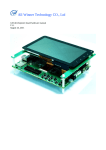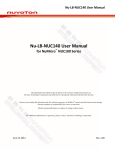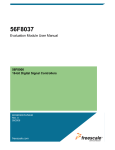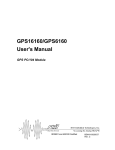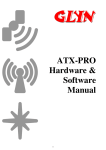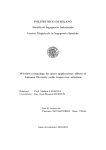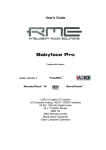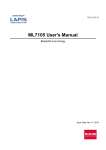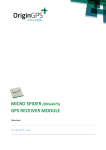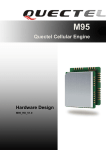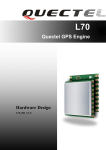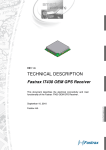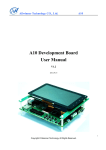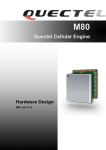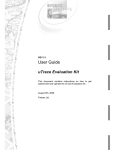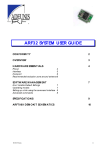Download Technical Description
Transcript
REV 2.7 Technical Description Fastrax IT03 OEM GPS Receiver This document describes the electrical and main functionality of the Fastrax IT03 hardware. April 23, 2010 Fastrax Ltd. 2010-04-23 Page 2 of 38 IT03 Technical Description_27.doc TRADEMARKS Fastrax is a registered trademark of Fastrax Ltd. All other trademarks are trademarks or registered trademarks of their respective holders. COPYRIGHT ©2003… 2010, Fastrax Ltd. DISCLAIMER This document is compiled and kept up-to-date as conscientiously as possible. Fastrax Ltd. cannot, however, guarantee that the data are free of errors, accurate or complete and, therefore, assumes no liability for loss or damage of any kind incurred directly or indirectly through the use of this document. The information in this document is subject to change without notice and describes only generally the product defined in the introduction of this documentation. 2010-04-23 Page 3 of 38 IT03 Technical Description_27.doc CHANGE LOG Rev. Notes Date 1.1 Preliminary documentation 2003-08-05 1.2 SPI2SDO I/O direction in 3.2 2003-08-28 1.3 Major update 2003-11-17 1.4 Updated I/O pin usage 2004-01-21 1.5 Updated I/O pin usage and application circuit 2004-02-02 1.6 Check by SW team 2004-05-27 1.7 Added moisture sensitivity information 2004-06-16 1.8 Contact 17 in page 13, modified chapter 6.1 2004-09-30 1.9 Wake-up, pin states, chapt. 4.6, ref. design 2004-12-02 2.0 Tables 3 & 4, chapt. 4.6.5, figures 6 & 7 2005-02-23 2.1 Added iTrax03 Application Board documentation 2005-09-01 2.2 Added pin description to chapter 6. 2005-09-06 2.3 Fixed some typing errors 2005-11-28 (2.4) Added recommendations for wiring unused GPIO pins (abandoned) 2006-06-30 2.5 PCB upgrade, module name change to IT03, corrected internal pull up/own resistor values, corrected Wakeup control input interrupt signal type to pulse 2009-05-27 2.6 Added disclaimer and marking codes 2010-03-16 2.7 Added notes and spec on ESD, ultrasonic sensitivity and RoHS; updated disclaimer 2010-04-23 2010-04-23 Page 4 of 38 IT03 Technical Description_27.doc CONTENTS _______________________________________________________________________ 1 2 3 4 GENERAL DESCRIPTION............................................................................... 7 1.1 Block Diagram ...................................................................................... 7 1.2 Frequency Plan ..................................................................................... 7 SPECIFICATIONS ........................................................................................... 9 2.1 General.................................................................................................. 9 2.2 Absolute maximum ratings ................................................................ 10 OPERATION.................................................................................................. 11 3.1 Operating modes ................................................................................ 11 3.2 Navigation/Idle mode.......................................................................... 11 3.3 Navigation/Idle mode.......................................................................... 11 3.4 Programming mode ............................................................................ 12 CONNECTIVITY ............................................................................................ 13 4.1 Connection assignments ................................................................... 13 4.2 Power supply (pins 18, 27)................................................................. 14 4.3 Reset (pin 12)...................................................................................... 15 4.4 Watchdog ............................................................................................ 15 4.5 Shared functionality ........................................................................... 15 4.6 Dedicated GPIO .................................................................................. 16 4.7 4.6.1 Boot Select (pin 16) ................................................................. 16 4.6.2 UI Indicators (pins 8, 9, 15) ...................................................... 17 4.6.3 On/Off control input (pin 14) ..................................................... 17 4.6.4 Wakeup control input ............................................................... 18 4.6.5 Sleep mode and I/O ................................................................. 18 Antenna input (pin 21)........................................................................ 20 4.7.1 Active GPS antenna ................................................................. 20 4.8 PPS output (pin 33) ............................................................................ 20 4.9 Serial ports ......................................................................................... 21 4.10 SPI-bus................................................................................................ 21 4.11 Capture timers (pins 34, 37)............................................................... 21 4.12 Pulse measurement inputs (pins 30, 31) ........................................... 21 4.13 MMC bus (pins 6, 8, 9) ........................................................................ 21 4.14 Mechanical dimensions and contact numbering .............................. 21 4.15 Suggested pad layout ........................................................................ 23 2010-04-23 Page 5 of 38 IT03 Technical Description_27.doc 5 6 7 REFERENCE DESIGN................................................................................... 24 5.1 Minimum Application Circuit Diagram .............................................. 24 5.2 Enhanced Application Circuit Diagram ............................................. 25 5.3 PCB layout issues .............................................................................. 26 IT03 APPLICATION BOARD ......................................................................... 28 6.1 General................................................................................................ 28 6.2 I/O Card Terminal connector.............................................................. 28 6.3 Bill of Materials................................................................................... 30 6.4 Application Board Circuit Drawing.................................................... 31 6.5 Application Board, Components layout ............................................ 32 6.6 Application Board, Artwork layer 1 ................................................... 32 6.7 Application Board, Artwork layer 2 ................................................... 33 6.8 Application Board, Artwork layer 3 ................................................... 33 6.9 Application Board, Artwork layer 4 ................................................... 34 HANDLING INSTRUCTIONS ......................................................................... 35 7.1 Assembly ............................................................................................ 35 7.2 Suggested Reflow soldering profile .................................................. 35 7.3 Moisture sensitivity ............................................................................ 35 7.4 Tape and reel ...................................................................................... 35 7.5 Marking ............................................................................................... 35 2010-04-23 Page 6 of 38 IT03 Technical Description_27.doc COMPLEMENTARY READING The following reference documents are complementary reading for this document: Ref. # File name Document name 1 PRO_NMEA.html Fastrax NMEA Protocol Specification 2 uN8130T_UM.pdf uN8130 User’s manual 3 Reflow_soldering_ profile.pdf Soldering Profile 2010-04-23 Page 7 of 38 IT03 Technical Description_27.doc 1 GENERAL DESCRIPTION Fastrax IT03 is a GPS receiver module for the OEM market segment. It integrates the GPS chip set from Atheros: the RF down-converter uN8021 and the processor uN8130. The processor includes all base band functions needed for GPS signal acquisition, tracking and navigation. Dedicated high-performance search engine architecture enables a rapid search of visible satellites. A 12 channel tracking unit insures that positioning is possible even in severe conditions such as weak signals in urban canyons. The processor provides also an internal watchdog timer. The IT03 module interfaces to the customer’s application via a versatile I/O bus and supports several external devices including timers, pulse measurement inputs and an MMC bus. All the peripherals have a shared functionality with general purpose input/output (GPIO) signals. Firmware features include e.g. build in data logger for position storage to embedded flash memory. The antenna input supports passive and active antennas and provides also an internal antenna bias supply. This document describes the electrical connectivity and main functionality of the IT03 hardware. 1.1 Block Diagram Figure 1 1.2 Block diagram Frequency Plan Clock frequencies generated internally at the IT03 receiver: 2010-04-23 Page 8 of 38 IT03 Technical Description_27.doc • 32768 Hz Real Time Clock (RTC) • 16.3574 MHz Master Clock • 1574.40 MHz Local Oscillator of the RF down-converter 2010-04-23 Page 9 of 38 IT03 Technical Description_27.doc 2 SPECIFICATIONS 2.1 General Table 1 General specifications Receiver GPS L1 C/A-code, SPS Channels 12 Update rate < 5 Hz, 1 Hz (default). Supply voltage range, VDDRF +2.7V…+3.3 V, low ripple 2mV(RMS) max. Supply voltage range, VDDDIG +2.7V…+3.3 V Power consumption 100 mW typical (without antenna bias) Antenna net gain range 0…+32 dB Antenna bias voltage Same as VDDRF Antenna bias current Must be limited externally by VDDRF supply to 150mA max. Operating temperature and storage -40ºC…+85ºC Serial port configuration Port 0: NMEA (default), iTALK optional Port 1: iTalk Serial data format 8 bits, no parity, 1 stop bit Serial data speed 600, 1200, 2400, 4800, 9600, 14400, 19200, 28800, 38400, 57600, 115200, 230400, 460800, 921600 baud. NMEA: 4800(default), iTalk: 115200(default). I/O signal levels CMOS compatible: low state 0.0…0.3xVDDDIG; high state 0.7…1.0xVDDDIG I/O sink/source contact capability per PPS modes Accessory I/O functionality with GPIO) +/- 4 mA max. Off, Survey, Static, Roving (default) (shared 2xCapture Timers, 2xPulse Measurement Inputs, 1xSPI-bus, MMC bus 2010-04-23 Page 10 of 38 IT03 Technical Description_27.doc 2.2 Absolute maximum ratings Table 2 General specifications Item Min Max unit Operating and storage temperature -40 +85 ºC 500 mW Power dissipation Supply voltage, VDDDIG -0.3 +3.6 V Supply voltage, VDDRF -0.3 +3.6 V Current on any I/O pin except antenna input -30 +30 mA Current output on antenna input 0 +100 mA Input voltage on any input connection -0.3 VDDDIG + 0.3 V +160 V +15 dBm ESD voltage (RFIN, Machine Model) RFIN input power - Note that module is Electrostatic Sensitive Device (ESD). 2010-04-23 Page 11 of 38 IT03 Technical Description_27.doc 3 OPERATION 3.1 Operating modes After power-up IT03 boots from the internal Flash memory for normal operation. Modes of operation: 3.2 • Navigation/Idle mode • Sleep mode • Programming mode Navigation/Idle mode The IT03 receiver enters Navigation mode after it has powered up. By default it will start navigation automatically after power-up or reset in Auto Start mode. Auto Start mode means that all available aiding information will be used. The module operates as long as the power supply is available. Idle mode means that the navigation is stopped but the processor remains active. Navigation/Idle mode is also referred as Normal Mode. The standard firmware supports versatile configuration of various operating configurations, e.g. Logging position data etc., for further details see ref 1. The navigation can be stopped by sending a proper NMEA or iTALK message, see also ref 1. 3.3 Navigation/Idle mode The Sleep mode means low power operation during which no other activity other that the internal real time clock (RTC) is present. The module enters Sleep mode via a special control message (ref #1) or by the On/Off Control input. The exit from the Sleep mode to the Normal mode happens in the following situations: • an elapsed time • an RS-232 break signal or a dummy input character to selected serial port (the low input state should exceed 20ms) • an interrupt from the On/Off Control input (low-to-high transition) • an interrupt from the Wake-up input (low-high-low pulse > 20ms). Since the internal RTC keeps the GPS time estimate, the module performs the fastest possible navigation start depending on the availability of valid satellite/position data. 2010-04-23 Page 12 of 38 IT03 Technical Description_27.doc 3.4 Programming mode The module enters Programming mode by two methods: HW-booting or upgrading the firmware on-the-fly by a dedicated NMEA or iTalk command, see ref 1. The on-the-fly upgrading requires only the serial Port 0. The downloading will start by sending a special serial port command, after which the utility running on the host will send the new firmware to the processor. HW-booting is utilized by keeping the Boot Select input (pin 16, SPI2XCS3/ GPIOB22) at logic low during power-up or system reset. Now the GPS module boots from the serial data Port 0, sends hex 55 (U) string at 9600 baud and waits the for the boot loader commands from the host (an application running on the host). This mode is required when there is no existing firmware stored into the internal Flash memory. It is recommended to support hardware based re-programming (HW-booting) in an IT03 application. This is done by adding Boot Select and XRESET control inputs into the design. See the reference design. 2010-04-23 Page 13 of 38 IT03 Technical Description_27.doc 4 CONNECTIVITY 4.1 Connection assignments The I/O connections are available as soldering pads with castellated via holes on the bottom side of the module. These pads are also used to attach the module on the motherboard in the application. All unused I/O pins should be left open (floating). Table 3 Full system connection description of IT03. Some pins can function as GPIO pins or in a special mode depending on the software configuration. Pin Signal name I/O Alternative GPIO name Signal description 1 GND - - Ground 2 SPI1XCS0 O GPIOB10 SPI1 chip select 0, GPIO reserved for future use. Do not connect. 3 SPI1CLK O GPIOB13 SPI1 clock 4 SPI1SDO O GPIOB14 SPI1 data output 5 SPI1SDI I GPIOB15 SPI1 data input, Wake-up input (2) 6 MMCCLK O GPIOA12 MMC clock output 7 GND - - Ground 8 MMCCMD I/O GPIOA13 MMC command bus, UI indicator B 9 MMCDAT I/O GPIOA14 MMC data bus, UI indicator A 10 GND - - Ground 11 SPI2CLK I/O GPIOB16 SPI2 clock, output in master mode 12 XRESET I - Active low async. system reset (3) 13 GND - - Ground 14 SPI2SDI I GPIOB18 SPI2 data input, On/Off control input (1) 15 SPI2SDO O GPIOB17 SPI2 data output, UI indicator C 16 SPI2XCS3 I/O GPIOB22 SPI2 chip select3, Boot Select. Pull high with external 4.7kohm resistor. 17 SPI2XCS2 O GPIOB21 SPI2 chip select2, (2nd boot select) 18 VDDRF I - VDD for RF circuits 19 GND - - Ground 20 GND - - Ground 21 RFIN I - RF input, antenna bias output 2010-04-23 Page 14 of 38 IT03 Technical Description_27.doc 22 GND - - Ground 23 TXD1 O GPIOA3 UART 1 async. output 24 RXD1 I GPIOA2 UART 1 async. input 25 TXD0 O GPIOA1 UART 0 async. output 26 GND - - Ground 27 VDDDIG I - VDD for digital circuits 28 RXD0 I GPIOA0 UART 0 async. input 29 FCLK O GPIOA4 Pre-divided clock output of UART 1 30 PM0 I GPIOA5 Pulse measurement input 0 31 PM1 I GPIOA6 Pulse measurement input 1 32 GND - - Ground 33 PPS O GPIOA7 1PPS signal output 34 TCAP0 I GPIOA9 Timer TMG0 capture input 35 TIN0 I GPIOA8 Timer TMG0 external clock input 36 TIN1 I GPIOA10 Timer TMG1 external clock input 37 TCAP1 I GPIOA11 Timer TMG1 capture input Pin Signal name I/O Alternative GPIO name Signal description Note (1): The input has internal 18kohm pull-up resistor. Note (2): The input has internal 9kohm pull-down resistor. Note (3): The input has internal 100kohm pull-up resistor. 4.2 Power supply (pins 18, 27) The IT03 module requires two separate power supplies: VDDRF for the RF parts and VDDDIG for digital parts and I/O bus. Note that VDDDIG supply input contains internal ceramic 1uF low ESR (0.01ohm) by-pass capacitor. Use a power supply that is specified for low ESR (<0.01ohm) output capacitor loads. VDDDIG and VDDRF should be powered up at the same time within a few ms. NOTE VDDDIG power supply should be compatible with low ESR (<0.01ohm) ceramic capacitors. 2010-04-23 Page 15 of 38 IT03 Technical Description_27.doc VDDRF must be linearly regulated having a low ripple 2mV(RMS) max. The typical current drain is 24 mA in Normal (Navigation) mode. Note that VDDRF is also provided internally at the antenna input as an active antenna bias. NOTE VDDRF supply current should be limited externally below 150 mA max. NOTE VDDRF supply voltage should have a low ripple 2mV(RMS) max. The VDDDIG supply may be shared with any available supply that meets the specified voltage range. A typical current is 12 mA in Normal (Navigation) mode but it may peak up to 40 mA for short durations. The VDDDIG supply voltage ripple should be below 40mV (RMS). 4.3 Reset (pin 12) The system reset input (pin 12, XRESET), is an active low asynchronous reset. The processor boots after an XRESET low-to-high transition. The XRESET input contains a 100k ohm pull-up resistor, an open-source Power-on-Reset (POR) circuit and a Schmitt trigger in order to eliminate the effect of noise. The POR is connected in parallel with the XRESET input and it overrides XRESET during power-up. For normal operation the XRESET input can be left unconnected. The module will independently handle the reset during power-on. However, to enable the hardware re-programming, it is advisable to connect the XRESET input for example to an open-collector or an open-source control output. 4.4 Watchdog The processor contains a watchdog peripheral, which resets the processor if not refreshed frequently enough. Basically the watchdog is a 16-bit counter with enabling, disabling and restarting controls. The watchdog counter is clocked with the frequency of 128 Hz. 4.5 Shared functionality All the I/O pins have a shared functionality. These pins can be programmed either to have a special function (PM, SPI, MMC etc.) or a general purpose I/O (GPIO) function. Each signal is named according to the special functionality but also the secondary functionality is listed as Alternative GPIO in Table 3. With the standard firmware there are dedicated GPIO connections, which are: Boot Select, UI Indicators and the control inputs. These shall be described in the following chapters. 2010-04-23 Page 16 of 38 IT03 Technical Description_27.doc 4.6 Dedicated GPIO 4.6.1 Boot Select (pin 16) The boot source is defined in the internal boot ROM sector by using pins 16 (GPIOB22 / SPI2XCS3) and 17 (GPIOB21 / SPI2XCS2). After a power-up or a system reset these pins are internally configured to a 9kohm ohm pull-down mode for 300 clock cycles (10 µs), after which their logic states are read. Thus, if there is nothing connected to pin 16 or 17, these pins will be pulled low and the software will be loaded from UART Port 0. The boot source (internal Flash memory, UART Port 0 or SPI1 bus) is processed according to Table 5. For normal module operation pin 16 must be pulled high to VDDDIG with a 4.7k ohm pull-up resistor. Pin 17 can be left floating. Pin 16 is referred as Boot Select in this document. It should be connected in the application in order to enable the hardware based re-programming. Table 4 Boot source selection Pin 16 Pin 17 I/O Boot source High High I External boot sector (Flash), in case of failure continue with SPI1 boot High Low I External boot sector (Flash), in case of failure continue with UART Port 0 boot Low High I SPI1 boot Low Low I UART Port 0 boot Normally, after XRESET low-to-high transition, the appropriate boot selection should be kept active for at least 30 us. However, after connection of VDDDIG and VDDRF, the desired boot selection should be kept active for at least 100 ms, which is due to the internal POR delay on the XRESET signal. NOTE To ensure normal operation during system reset and power on, the Boot Select (pin 16, SPI2XCS3 / GPIOB22) requires an external pull-up resistor connected to VDDDIG, e.g. 4.7 kohm. Respectively, pin 17 (SPI2XCS2 / GPIOB21) should be left open or connected to a pull-down resistor (e.g. 4.7 kohm). 2010-04-23 Page 17 of 38 IT03 Technical Description_27.doc 4.6.2 UI Indicators (pins 8, 9, 15) The standard firmware includes three GPIO outputs reserved as drivers for User Interface (UI) Indicators. These outputs can be used for example to drive LEDs, which give information on the state of the receiver. Table 5 UI Indicators UI Indicator Pin number I/O Operation: High ratio % Signal description A 9 O Continuously low state Power Off or Sleep mode A 9 O Short blink 20 Normal mode, Navigation stopped A 9 O Long blink 80 Normal mode, Navigation started B 8 O Continuously low state Navigation stopped or not tracking satellites B 8 O Short blink 20 Tracking satellites but not enough information to calculate pseudoranges B 8 O Long blink 80 Pseudorange information but not navigating B 8 O Continuously high state Navigating, Valid fix C 15 O Low state No valid fix C 15 O High state Valid fix available available The UI Indicators are updated synchronously at 1 Hz rate. The high state duty cycle is either 0% (i.e. continuously logic low), 20% (Short blink), 80% (Long blink) or 100% (i.e. continuously logic high). Pin 15 (SPI2SDO / GPIOB17) indicates when a fix is available: the pin is logic high when location fix is valid and logic low when the location fix is invalid. 4.6.3 On/Off control input (pin 14) With the standard firmware the module can be commanded to Sleep mode by the On/Off control input (pin 14, SPI2SDI / GPIOB18) or by a specific command. During Sleep mode only the real time clock is running and the current consumption is reduced to about 20 uA. Note that the worst case delay from the On/Off Control high-to-low transition to achieve Sleep mode and reduced current drain is 300 ms. The standard firmware stores the last known good position (LKG) and any Log data to the internal Flash memory before entering the Sleep mode. 2010-04-23 Page 18 of 38 IT03 Technical Description_27.doc Table 6 On/Off control On/Off Control, pin 14 I/O Signal description High state I Normal (navigating) mode, delay from Sleep mode 3 ms Low state I Sleep mode, delay from Normal mode 300 ms max. NOTE With the standard firmware the On/Off control input (pin 14, SPI2SDI / GPIOB18) has an internal 18k ohm pull-up resistor connected to VDDDIG and the signal can be left unconnected for normal operation. During Sleep mode the input is switched internally to pull-down 9kohm resistor. 4.6.4 Wakeup control input With the standard firmware the module can be wake up from sleep state by the Wake Up control input (SPI1SDI / GPIOB15, pin #5) depending on the sleep mode wakeup mask. Wake Up input is normally used only when the module has entered sleep state using the specific serial command. Wake up interrupt is generated by a low-high-low pulse to the Wake Up control input. The pulse length should be at least 20 ms. The input has an internal 9kohm pull-down resistor and can be left unconnected for normal operation. 4.6.5 Sleep mode and I/O During the Sleep mode almost all the I/O pins are configured as inputs with internal 100k ohm pull-down resistors. In order to reduce current leakage there are few exceptions, see Table 9. Table 7 Pin states in Sleep mode (default firmware) Pin Pin mode I/O GPIO mode Signal description 1 GND - - Ground 2010-04-23 Page 19 of 38 IT03 Technical Description_27.doc 2 GPIOB10 I Pull-down GPIO input, 9k ohm pull-down 3 GPIOB13 I Pull-down GPIO input, 9k ohm pull-down 4 GPIOB14 I Pull-down GPIO input, 9k ohm pull-down resistor 5 GPIOB15 I Pull-down GPIO input, keeper 6 GPIOA12 I Pull-down GPIO input, 9k ohm pull-down 7 GND - - Ground 8 GPIOA13 I Pull-down GPIO input, 9k ohm pull-down 9 GPIOA14 I Pull-down GPIO input, 9k ohm pull-down 10 GND - - Ground 11 GPIOB16 I Pull-down GPIO input, 9k ohm pull-down 12 XRESET I - Active low async. system reset 13 GND - - Ground 14 GPIOB18 I Pull-down GPIO input, pull-down (Stays as pull-up if NMEA Sleep command was used in Normal mode.) 15 GPIOB17 I Pull-down GPIO input, 9k ohm pull-down 16 GPIOB22 I Pull-down GPIO input, 9k ohm pull-down 17 GPIOB21 I Pull-down GPIO input, 9k ohm pull-down 18 VDDRF I - VDD for RF circuits 19 GND - - Ground 20 GND - - Ground 21 RFIN I - RF input, antenna bias output 22 GND - - Ground 23 GPIOA3 I Pull-up GPIO input, 18k ohm pull-up 24 GPIOA2 I Pull-up GPIO input, 18k ohm pull-up 25 GPIOA1 I Pull-up GPIO input, 18k ohm pull-up 26 GND - - Ground 27 VDDDIG I - VDD for digital circuits 28 GPIOA0 I Pull-up GPIO input, 18k ohm pull-up 29 GPIOA4 I Pull-down GPIO input, 9k ohm pull-down 30 GPIOA5 I Pull-down GPIO input, 9k ohm pull-down 31 GPIOA6 I Pull-down GPIO input, 9k ohm pull-down 2010-04-23 Page 20 of 38 IT03 Technical Description_27.doc 4.7 32 GND - - Ground 33 GPIOA7 I Pull-down GPIO input, 9k ohm pull-down 34 GPIOA9 I Pull-down GPIO input, 9k ohm pull-down 35 GPIOA8 I Pull-down GPIO input, 9k ohm pull-down 36 GPIOA10 I Pull-down GPIO input, 9k ohm pull-down 37 GPIOA11 I Pull-down GPIO input, 9k ohm pull-down Contact Pin mode I/O GPIO mode Signal description Antenna input (pin 21) The module supports passive and active antennas. The antenna input impedance is 50 ohms. The input provides also a bias supply during normal navigation operation. The antenna bias voltage is the same as the VDDRF supply. In the Sleep mode the antenna bias voltage is cut off internally. The maximum tolerated antenna bias current is 100mA. It is current limited only by the external regulator supplying VDDRF. The VDDRF supply current should be externally limited to 150 mA max. NOTE Passive antennas with short-circuit to GND should be DC blocked externally with a series capacitor 18pF… 1nF. 4.7.1 Active GPS antenna The customer may use an external active GPS antenna for e.g. in mobile or indoor usage. It is suggested the active antenna has a net gain including cable loss in the range from +6 dB to +32 dB. 4.8 PPS output (pin 33) The PPS output provides a pulse-per-second signal, which can be used for timing purposes. The default PPS mode is Roving, i.e. timing pulse is available after valid fix based on the current valid fix position. The operating mode, pulse length and polarity are configurable via NMEA or iTALK. Other modes are Static, Survey and Off, see ref 1 for details. 2010-04-23 Page 21 of 38 IT03 Technical Description_27.doc 4.9 Serial ports The device supports UART communication via Port 0 (RXD0 & TXD0) and Port 1 (RXD1 & TXD1). With the standard firmware Port 0 is configured to NMEA by default and secondary to iTALK protocol. Port 0 is also used when the device is booting from the serial port. With the standard firmware Port 1 is configured for iTALK communication by default and secondary to RTCM. The serial port logic levels are CMOS compatible. Thus, they are not directly compatible with RS232 logic levels. Use an external level converter to provide RS-232 levels, if needed. Refer to ref 1 for supported data speeds. 4.10 SPI-bus The SPI1 in reserved internally for the RF-down-converter and externally for a custom boot mode. Only the SPI2 device (master) is available for SDK users enabling SPI communication. 4.11 Capture timers (pins 34, 37) Two general-purpose timers are available for SDK users with a custom firmware. TMG0 and TMG1 have configurable prescalers and clock cycle counts. The clock input is selectable between three sources and there is a capture mode to count external events. Each timer also has a programmable delay, referenced to the internal epoch pulse (TME). This makes it possible to have a specified delay between interrupts generated by the internal TME epoch, TMG0, and TMG1. For details see ref 2. 4.12 Pulse measurement inputs (pins 30, 31) The two pulse measurement (PM) inputs are available for SDK users with a custom firmware. PM inputs can be used to measure with great accuracy how long an input stays high or low. For details see ref 2. 4.13 MMC bus (pins 6, 8, 9) The MMC bus is available for SDK users with a custom firmware. The MMC unit implements a standard 3-wire Multi Media Card serial bus interface and provides control and data register for easy usage of the bus. Both stream and block mode data transfers are supported. The CRC is calculated automatically for transmitted commands and data blocks, also received responses and data blocks are checked for correct CRC. The MMC unit has a 64-bit data buffer and is capable of stopping bus clock to prevent buffer overflow and underflow situations. For details see ref 2. 4.14 Mechanical dimensions and contact numbering Board size is 22.0mm (width) x 23.3mm (length) x 2.6mm (height 3.1mm max). General tolerance is ±0.3mm. I/O contacts are using castellated via holes, which allows also hand soldering and visual inspection of solder wetting. 2010-04-23 Page 22 of 38 IT03 Technical Description_27.doc Figure 2 Figure 3 Dimensions Contact numbering, top view through the package. 2010-04-23 Page 23 of 38 IT03 Technical Description_27.doc Figure 4 Pad dimensions, bottom view. 4.15 Suggested pad layout Figure 5 Suggested pad layout, top view through the package. Dimensions are in mm. 2010-04-23 Page 24 of 38 IT03 Technical Description_27.doc 5 REFERENCE DESIGN The idea of the reference design is to give a guideline for the applications using the IT03 GPS module. In the following two chapters the reader is exposed to design rules he should follow, when designing an IT03 based application. By following the rules one ends up having an optimal design with no unexpected behavior caused by the PCB itself. In fact these guidelines are quite general in nature, and can be utilized in any PCB design related to RF techniques or high speed logic. 5.1 Minimum Application Circuit Diagram The Minimum Application supports communication through the UART Port 0 (NMEA or iTALK). Other required signals are the antenna input, supply voltages for VDDRF and VDDDIG and a pull-up resistor for the Boot Select. Also, it is a good practice to make the IT03 application to support hardware based reprogramming of the module firmware. Due to this, one should connect Boot Select (pin 16, SPI2XCS3 / GPIOB22) in such a way, that it can be toggled to logic low for a firmware update through serial Port 0. In normal operation Boot Select is pulled high with a resistor (R1 in Figure 6). IT03 supports also software based “on-the-fly” programming. This does not require toggling of the Boot Select signal. However, this method is not completely protected against unexpected problems during the re-programming session. Because of this, the use of Boot Select in the design is recommended. The low drop-out linear regulator (LDO) U2 supplies +2.8 V voltage to the RF and analog parts (VDDRF) and the digital supply (VDDDIG) is taken directly from the main supply, which in this case is from +3.0 to +3.3 V due to the small drop-out voltage across U2. The linearly regulated power supply is needed for VDDRF, because the maximum allowed ripple voltage for VDDRF is 2 mV(RMS). The external regulator U2 can be omitted, if such a supply is available that meets the specified ripple voltage. All the digital signals are routed away from the module through series resistors (R2, R3). In this way the local oscillator (LO) signal leakage that is present in the I/O contacts of the GPS module is suppressed. Although the LO leakage is very small at the I/O contacts of the module, it may still interfere with the GPS reception, especially when the antenna is located very near to these signal routes. For the same reason capacitors C1 and C2 should be connected very close to the module with short traces to I/O contacts and to ground plane. Additionally, there must be another capacitor (C3: 4.7uF or bigger) from VDDDIG to the ground. This capacitor can be located further away. If a signal from the IT03 is not needed, the corresponding pin can be left open. 2010-04-23 Page 25 of 38 IT03 Technical Description_27.doc Figure 6 Minimum Application Circuit Diagram. Note that there is a DC voltage present at the RF input, when the module is operating in Normal mode. This voltage is equal to VDDRF. If a passive antenna with short-circuit to the GND is used, an external series DC block capacitor (18pF) must be used. 5.2 Enhanced Application Circuit Diagram A more versatile functionality can be achieved by adding the On/Off control for the Sleep mode and the secondary UART Port 1. Note that there is also a Wake-up input in pin 5 (SPI1SDI / GPIOB15). One should also support hardware re-programming of IT03 by adding Boot Select control (pin 16, SPI2XCS3 / GPIOB22). See Chapter 5.1 for more details. 2010-04-23 Page 26 of 38 IT03 Technical Description_27.doc Figure 7 5.3 Enhanced Application Circuit Diagram. PCB layout issues The suggested 4-layer PCB build up is presented in the following table. Table 8 Suggested PCB build up Layer Description 1 Signal + Ground with keep-out below IT03 2 Ground plane 3 Signal + Ground or VDD plane 4 Signal (short traces) + Ground 2010-04-23 Page 27 of 38 IT03 Technical Description_27.doc Routing signals directly under the module should be avoided. This area should be dedicated to keep-out for traces and ground (copper), except for via holes, which can be placed close to the pad under the module. If possible, the amount of VIA holes underneath the module should be also minimized. For a multi-layer PCB the first inner layer below the IT03 is suggested to be dedicated for the ground plane. Below this ground layer other layers with signal traces are allowed. It is always better to route very long signal traces in the inner layers of the PCB. In this way the trace can be easily shielded with ground areas from above and below. The series resistors at the I/O pins should be placed very near to the IT03 module. In this way the risk for the local oscillator leakage is minimized. For the same reason the by-pass capacitors C1 and C2 should be connected very close to the module with short traces to I/O contacts and to the ground plane. Place the GND via holes as close to the capacitor as possible. Connect the GND soldering pads of IT03 to ground plane with short traces to via holes, which are connected to the ground plane. Use preferably two VIA holes per GND pad. The RF input should be routed clearly away from other signals. This minimizes the possibility of interference. The proper width for the 50 ohm transmission line impedance depends on the dielectric material of the substrate and on the height between the signal trace and the first ground plane. With an FR-4 material the width of the trace is about two times the substrate height. A board space free of any traces should be covered with copper areas (GND). In this way a solid RF ground is achieved throughout the circuit board. Several VIA holes should be used to connect the ground areas between different layers. Additionally, it is important that the PCB build-up is symmetrical on both sides of the PCB core. This can be achieved by choosing identical copper content on each layer, and adding copper areas to routing-free areas. If the circuit board is heavily asymmetric, the board may bend during the PCB manufacturing or re-flow soldering. Bending can cause soldering failures between the IT03 connection pads and the application board pads. 2010-04-23 Page 28 of 38 IT03 Technical Description_27.doc 6 IT03 APPLICATION BOARD 6.1 General The IT03 Application Board is intended for easy evaluation of the IT03 OEM GPS module and it is especially intended as a sub-system for the Evaluation Kit. It consists of the PCB board on which the surface mountable IT03 module is attached and two regulators, which provide two separate supply voltages +2.8V. The I/O Card Terminal connector provides all the available connectivity to the system connector of the Evaluation Kit. The MCX RF connector provides the access to the Antenna input. ITRAX03 Application Board Power Regulators System Connector iTRAX03 Module Serial Resistors Antenna Connector Figure 8 6.2 IT03 Application Board, Block Diagram. I/O Card Terminal connector The following signals are available at the I/O Card Terminal connector CON2. Table 9 Card Terminal Connections Pin Signal name I/O Alternative GPIO name Signal description 1 TXD1 O GPIOA3 UART 1 async. output 2 GND - - Ground 3 RXD1 I GPIOA2 UART 1 async. input 4 GND - - Ground 5 TXD0 O GPIOA1 UART 0 async. output 6 GND - - Ground 2010-04-23 Page 29 of 38 IT03 Technical Description_27.doc 7 RXD0 I GPIOA0 UART 0 async. input 8 GND - - Ground 9 VCC - - Power input 10 GND - - Ground 11 PPS O GPIOA7 1PPS signal output 12 GND - - Ground 13 XRESET I - Active low async. system reset 14 FCLK O GPIOA4 Pre-divided clock output of UART 1 15 SPI2XCS2 O GPIOB21 SPI2 chip select2, (2nd boot select) 16 SPI2XCS3 I/O GPIOB22 SPI2 chip select3, Boot Select 17 GND - - Ground 18 TCAP1 I GPIOA11 Timer TMG1 capture input 19 TIN0 I GPIOA8 Timer TMG0 external clock input 20 TIN1 I GPIOA10 Timer TMG1 external clock input 21 GND - - Ground 22 TCAP0 I GPIOA9 Timer TMG0 capture input 23 PM1 I GPIOA6 Pulse measurement input 1 24 PM0 I GPIOA5 Pulse measurement input 0 25 GND - - Ground 26 MMCCMD I/O GPIOA13 MMC command bus, UI indicator B O GPIOB10 SPI1 chip select 0, GPIO reserved for future use. Do not connect. 27 SPI1XCS0 28 MMCCLK O GPIOA12 MMC clock output 29 SPI1CLK O GPIOB13 SPI1 clock 30 MMCDAT I/O GPIOA14 MMC data bus, UI indicator A 31 GND - - Ground 32 SPI1SDO O GPIOB14 SPI1 data output 33 GND - - Ground 34 SPI1SDI I GPIOB15 SPI1 data input, Wake-up input 35 GND - - Ground 2010-04-23 Page 30 of 38 IT03 Technical Description_27.doc 36 SPI2CLK I/O GPIOB16 SPI2 clock, output in master mode 37 GND - - Ground 38 SPI2SDI I GPIOB18 SPI2 data input, On/Off control input 39 GND - - Ground 40 SPI2SDO O GPIOB17 SPI2 data output, UI indicator C Pin Signal name I/O Alternative GPIO name Signal description 6.3 Bill of Materials Referenc e C2 C 5-6 C1 C3-4 C7-8 CON 2 J1 U1 R1 R2 U 2-3 REN1 -6 Valu e 10n N/A 18p 4u7 22 0R 4k 7 22 0R Q ty 1 2 1 4 1 1 1 1 1 2 6 M an ufacturer M fg code MU RAT A Sam tec Hube r Suhn er Fas trax G RM 40-03 4X5R 475K 6.3 EMT -120 -01-S -D 82 MCX -S50-0-22/ 111N E IT 03 MA S Philip s MA S9161 AGA2 -T ARV2 41 Pa ckag e 040 2 040 2 040 2 080 5 SM D Edge mo unt SM D m odu le 040 2 040 2 T SOT 5 0 603*4 Part type Cap acitor Cap acitor Cap acitor C APAC ITO R Conn ector Conn ector Mo dule R esis tor R esis tor R egula tor R esis tor Desc ription X7R 10% X7R 10% NPO 10% X 5R 6.3 V SO CKET ST RIP 40 PIN S M CX SMD fem ale G PS Re ceive r R esisto r, 5% R esisto r, 5% LDO R esisto r Array 2010-04-23 Page 31 of 38 IT03 Technical Description_27.doc 6.4 Application Board Circuit Drawing 2010-04-23 Page 32 of 38 IT03 Technical Description_27.doc 6.5 Application Board, Components layout 6.6 Application Board, Artwork layer 1 2010-04-23 Page 33 of 38 IT03 Technical Description_27.doc 6.7 Application Board, Artwork layer 2 6.8 Application Board, Artwork layer 3 2010-04-23 Page 34 of 38 IT03 Technical Description_27.doc 6.9 Application Board, Artwork layer 4 2010-04-23 Page 35 of 38 IT03 Technical Description_27.doc 7 HANDLING INSTRUCTIONS 7.1 Assembly The IT03 module supports only assembly and soldering in a reflow process on the top side of the PCB. Suggested solder paste stencil height is 150um minimum to ensure sufficient solder volume. Note that module is Electrostatic Sensitive Device (ESD). Rated voltage is 160V max (Machine Model) at antenna input RFIN signal. NOTE Note that module is Electrostatic Sensitive Device (ESD), rating 160V max (Machine Model) at RFIN. Avoid also ultrasonic exposure due to internal crystal and SAW components. The module meets the requirements of Directive 2002/95/EC of the European Parliament and of the Council on the Restriction of Hazardous Substance (RoHS). For details contact Fastrax support. 7.2 Suggested Reflow soldering profile Use pre-heating at 150… 180 ºC for 60… 120 sec. Suggested peak reflow temperature is 235… 245ºC (for SnAg3.0Cu0.5 alloy). Absolute max reflow temperature is 260ºC. For details see Fastrax document ‘Soldering Profile’ (ref 3). 7.3 Moisture sensitivity Note that the IT03 is moisture sensitive at MSL 3 (see the standard IPC/JEDEC J-STD-020C). The module must be stored in the original moisture barrier bag or if the bag is opened, the module must be repacked or stored in a dry cabin (according to the standard IPC/JEDEC J-STD033B). Factory floor life in humid conditions is 1 week for MSL 3. 7.4 Tape and reel One reel contains 500 modules. 7.5 Marking Module marking includes type and batch codes and serial number. 2010-04-23 Page 36 of 38 IT03 Technical Description_27.doc Type code is e.g. IT0316-341D-STD-3278, where • IT0316 is IT03 with internal 16 Mbit flash memory • 341D is SDK revision 3.4.1 and D is incremental firmware release revision • STD is firmware configuration code • 3278 is BOM (Bill-of-Materials) revision code Batch code is e.g.190201, where • 1 is factory code • 9 is last digit of the year (e.g. 2009) • 02 is month (e.g. February) • 01 is incremental number of the production batch during the month Serial number is unique for each module having 10 digits including tester code, last two digits of the year, julian date code and incremental number. 2010-04-23 Page 37 of 38 IT03 Technical Description_27.doc Figure 9 IT03 Tape and Reel. 2010-04-23 Page 38 of 38 IT03 Technical Description_27.doc Contact Information Fastrax Ltd. Street Address: Valimotie 7, 01510 Vantaa, FINLAND Tel: +358 (0)424 733 1 Fax: +358 (0)9 8240 9691 http://www.fastraxgps.com E-mail: Sales: [email protected] Support: [email protected]






































